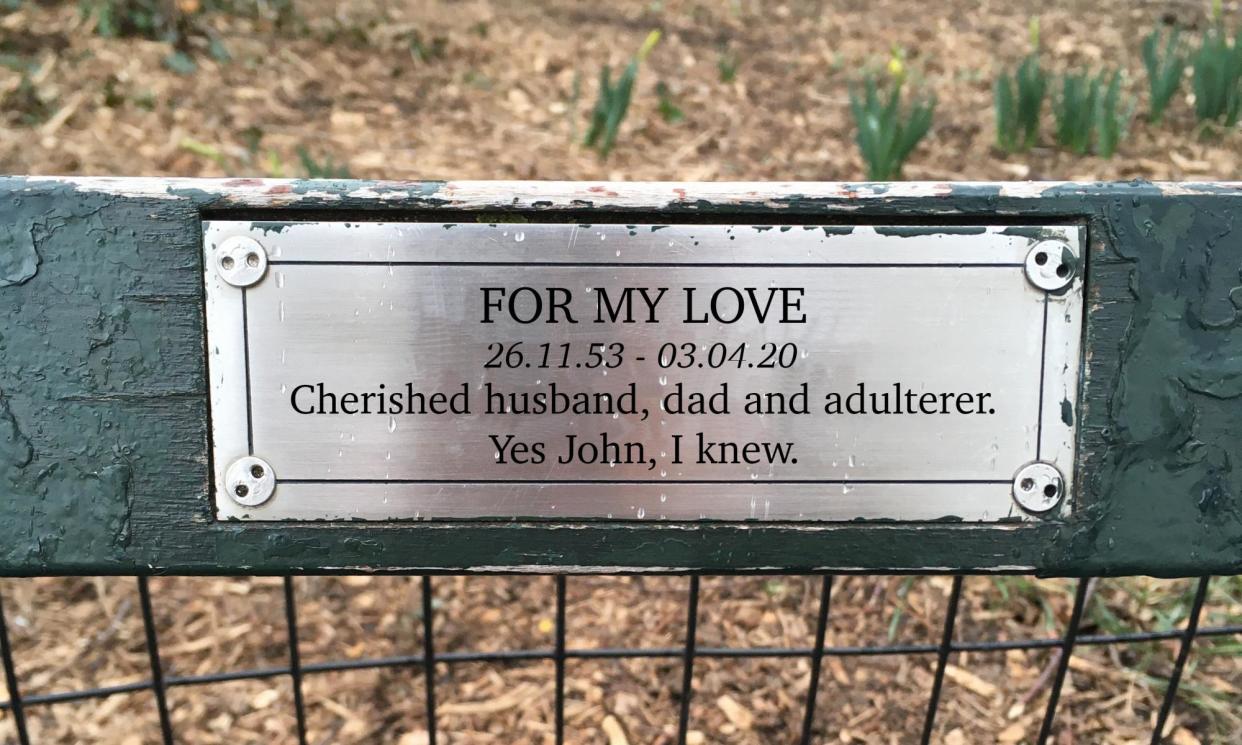‘It’s not Banksy’s; it’s mine’: artist says Bristol plaque to adulterer is a copy

It began as a story about a mysterious plaque on a Bristol bench – but the strange tale of an engraved tribute to a deceased adulterer is now raising wider questions about copyright and who gets credit for creativity in the art world.
Photos of the brass plate paying tribute to a supposedly deceased adulterer called Roger went viral last week, after it was affixed to a wooden bench on Royal York Crescent in the upmarket district of Clifton.
Who put up the plaque commemorating the “husband, father, adulterer” – which included the payoff line “Roger, I knew” – remains unknown. But while locals speculated that Banksy may have been involved, another artist has now suggested they are the victim of a rip-off.
The London-based creator, who operates under the name The Misfortuneteller, said they created a near-identical plaque in March 2020 after wandering around New York’s Central Park and looking at the inscriptions on benches.
“Plaques are fine but they’re not really that truthful,” they say. “I wanted to do honest memorial plaques. Bittersweet ones.”
He mocked-up a series of images featuring offbeat tributes to the deceased. Some of the designs were sold as real engraved plaques. An ex-girlfriend is commemorated with a real-life plaque reading: “For Barbara – Who was awful when hungry but otherwise pretty solid.”
Others took on a life of their own after going viral, often being shared without credit or posted by meme aggregation accounts on Instagram.
No one bought his design paying tribute to a “cherished husband, dad and adulterer”, even though the image proved popular online.
As a result, The Misfortuneteller said he was surprised to see his original design and phrasing reappear on the Bristol bench this week, prompting him to say: “It’s not Banksy’s; it’s fucking mine.”
Whoever put up the Bristol plaque had used almost exactly the same phrasing as the original 2020 design, albeit changing the name of the supposedly deceased adulterer. And while there is no suggestion they are seeking to profit from their actions, the original artist said they felt infuriated by the potential copyright infringement: “I’m mad at the person who took this, copied it, and put it on a bench. It’s a reflection of how intellectual property these days is so hard to enforce.”
He said there is a tension between delight at creating work that resonates with the public and not receiving any credit for it.
“It’s just interesting how things go viral – on the one hard you should be pleased that you’re amusing people,” he said. “But if a million people like your post you get nothing from it.”
Drawing a parallel to the early days of illegal music downloads on the internet, the artist said: “Even my followers say I should be happy. It’s a bit like Napster – the internet is used to getting things for free and they expect to get everything for free and not to credit everybody. There’s an assumption that if you find something amusing and share that the person doing it is doing really well.”
There is a long history of fake plaques in the UK. In 2013 a man emigrating to Australia left behind a bench inscription reading “In memory of Roger Bucklesby, who hated this park and everyone in it.” A fake English Heritage blue plaque commemorating the residence of Victorian timetraveller Jacob von Hogflume appeared on a London townhouse in 2012. And the artist Gavin Turk created a plaque as a mocking tribute to his own importance while still a young artist.
The Misfortuneteller insisted he does not want to stop others creating subversive plaques. He said appreciates it is a powerful and effective medium: “There are other artists in my orbit who have attempted to do plaques. I have never said I own all plaques, just like I don’t own ink and paper. I feel this is different because it’s word-for-word.”


